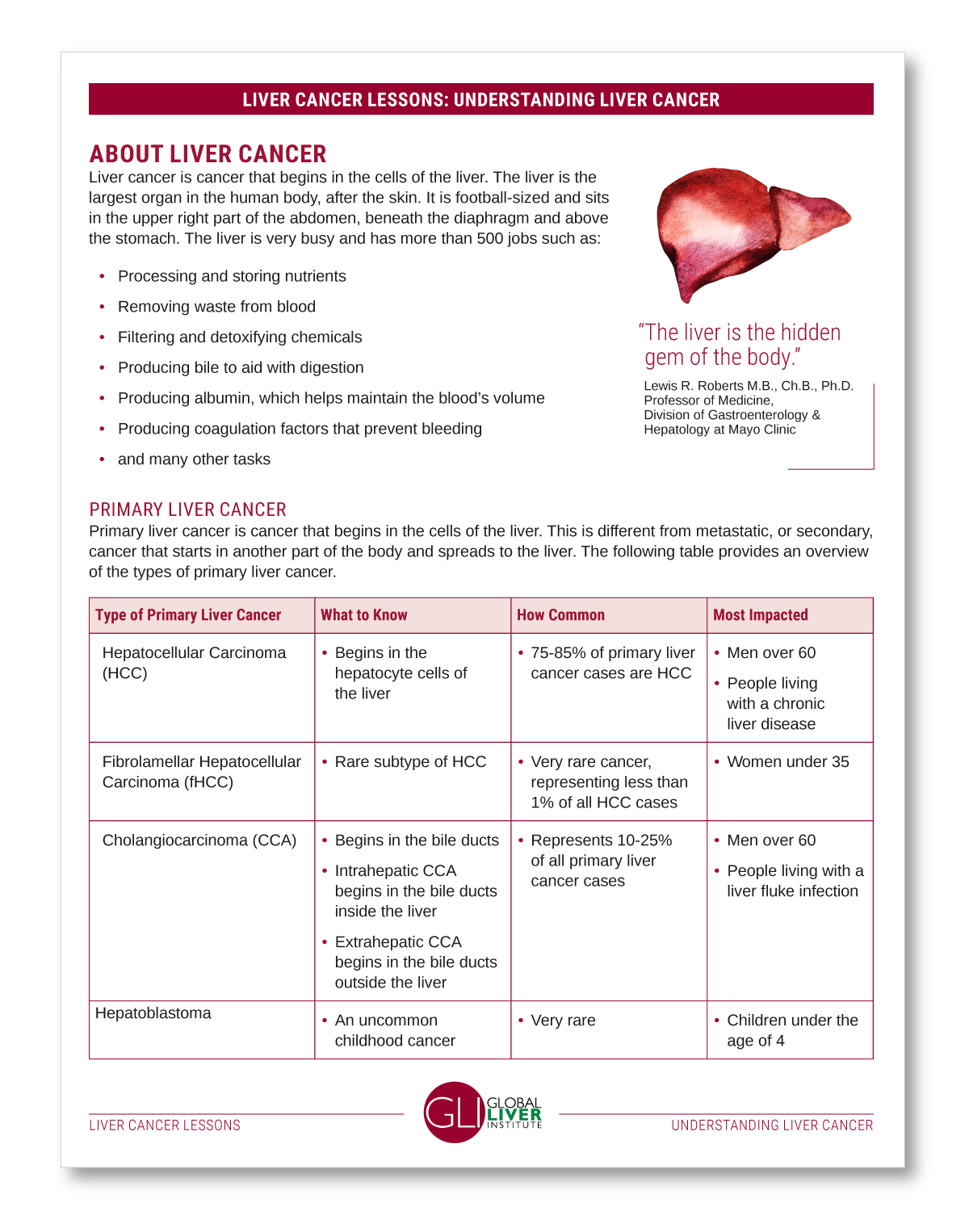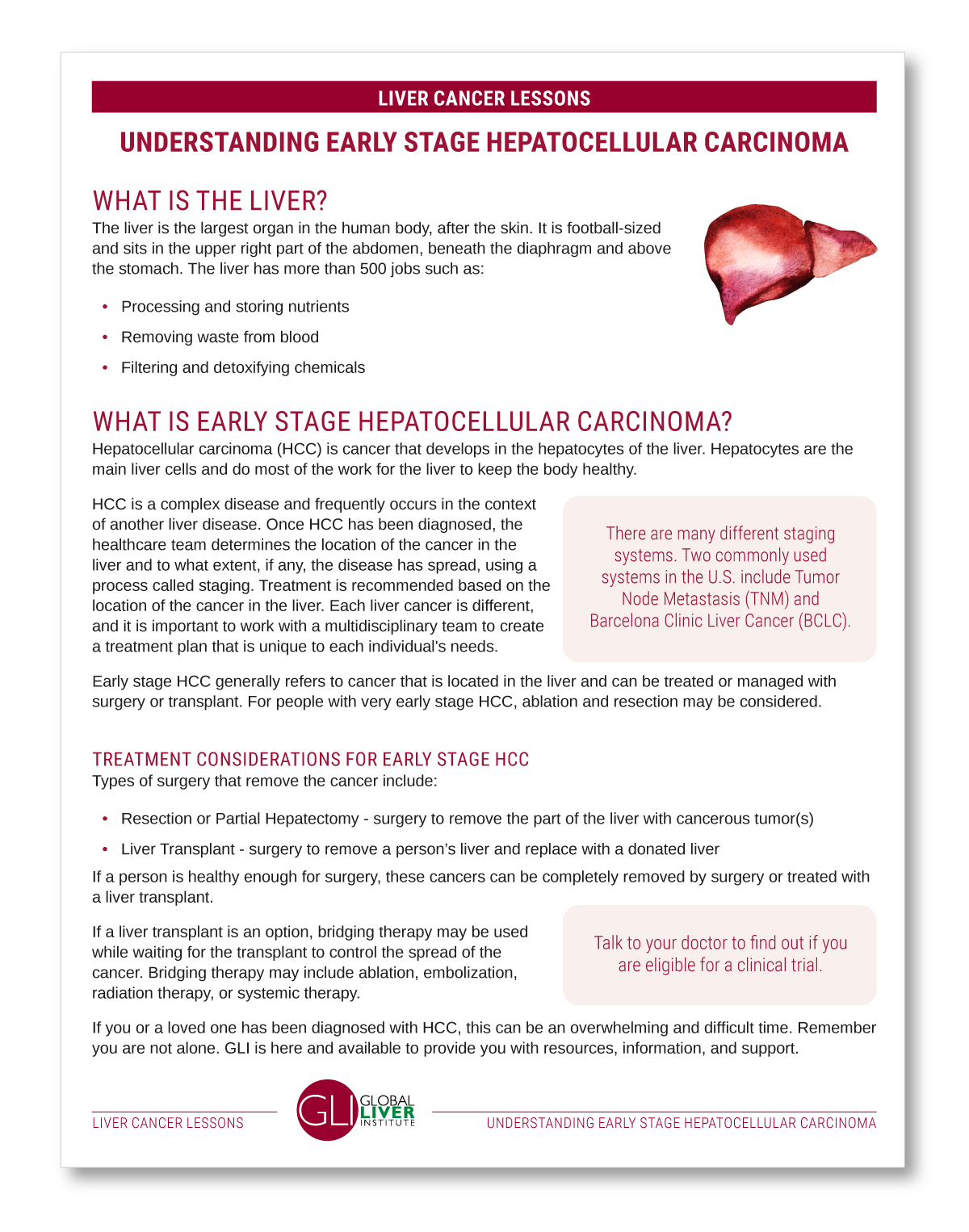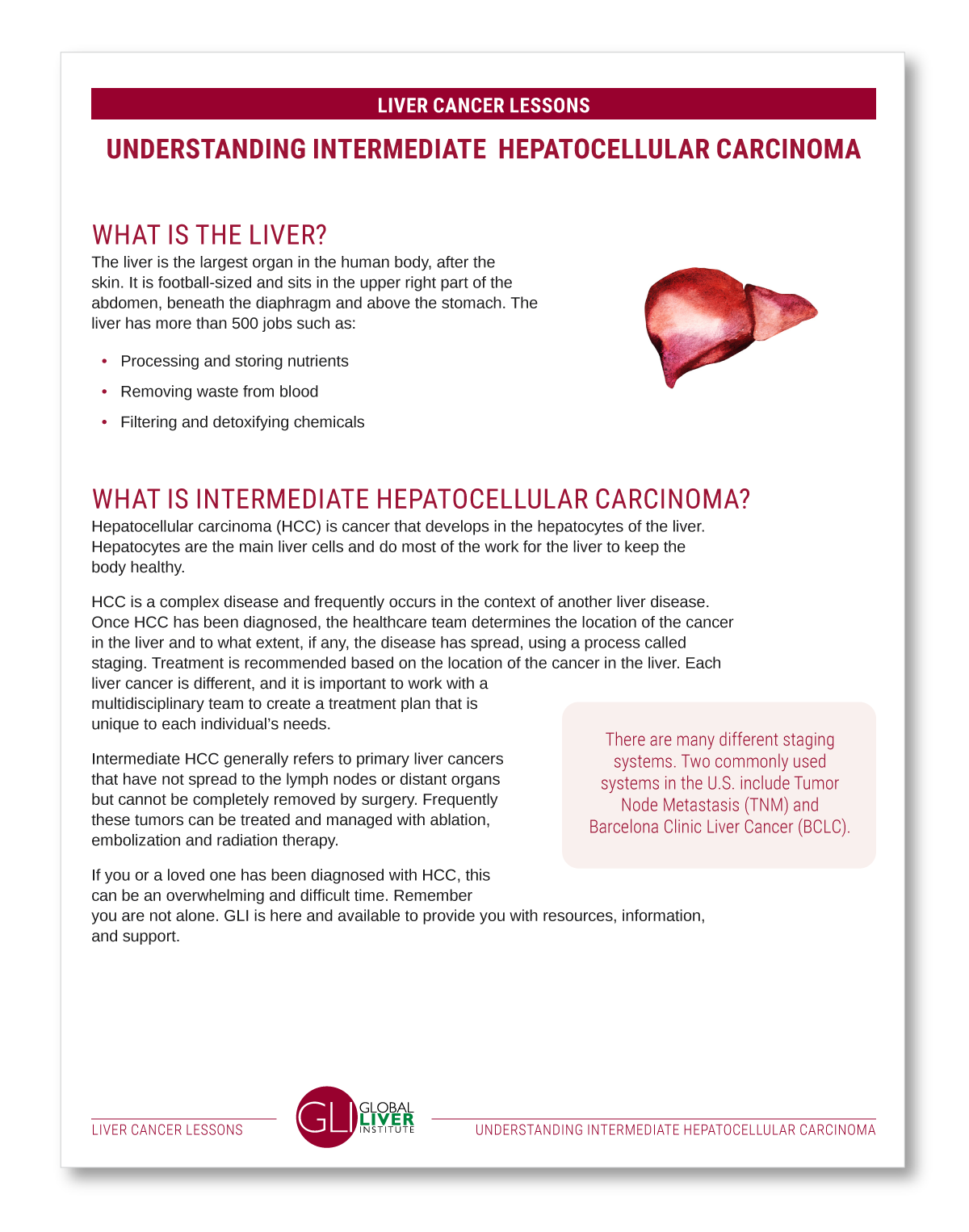GLI is proud to provide up to date and evidence based educational information about liver and bile duct cancers. Our information addresses topics important to anyone at risk for developing cancer in the liver and anyone who is living with the disease.
Liver cancer is a leading cause of cancer death worldwide. More than 800,000 people are diagnosed with liver cancer globally each year. The percentage of Americans who develop liver cancer has been rising for several decades. The American Cancer Society estimates that more than 42,000 Americans will hear the words “You have liver cancer” in 2020.
Fortunately, when diagnosed at an early stage, cancers of the liver can be treated effectively.
Liver Cancer Lessons Videos
Liver Cancer Lessons Shareables
About Liver Cancer
The Liver
The liver is the largest organ in the human body, after the skin. It is football sized and sits in the upper right part of the abdomen, beneath the diaphragm and above the stomach.
The liver is the largest organ in the human body, after the skin. It is football sized and sits in the upper right part of the abdomen, beneath the diaphragm and above the stomach. The liver is very busy and has more than 500 jobs such as:
Process and stores nutrients
Remove waste from blood
Filter and detoxify chemicals
Produce bile to aid with digestion
Produce albumin which helps maintain the blood volume
Produce coagulation factors that prevent bleeding
and many other tasks
Compared to other organs, the liver has an exceptional capacity to repair itself, or regenerate, when injured or damaged. This may be in part because it has the job of protecting the body against toxins and has to be able to replace any cells injured by exposure to toxins. While this regenerative capacity usually lasts a lifetime, in cases where there is ongoing chronic injury to the liver for an extended period of time, the liver exhausts its capacity to repair itself.
Cancer is a disease that begins in cells, which are the building blocks that make up all tissue and organs of the body, including the liver. Normal cells grow, divide, and die on a regular schedule. Sometimes something goes wrong with this process and the cells grow faster and don’t die as they should, creating a growth or tumor. Tumors can be benign, meaning not cancer, or malignant, meaning cancer.
What should you do if you or a loved one has just been diagnosed with cancer of the liver? First, take a moment to breathe. After that, your priority is to find out as much as you can about your diagnosis and work with your doctor to make a plan that is right for you or your loved one. Learning you or a loved one has liver cancer can be a scary and uncertain time. You are not alone and looking for information here on our website is a great start.
Primary liver cancer is cancer that begins in the cells of the liver.
Types of Primary Liver Cancers
There are different types of primary liver cancers. Liver cancers are named based on the type of cell they originate in or how they look under the microscope.
Hepatocellular Carcinoma (HCC) is the most common type of liver cancer making up approximately 85% of new liver cancer cases. Hepatocellular carcinoma is cancer that begins in the hepatocytes in the liver. Hepatocytes perform most of the processing and detoxifying work of the liver. Most HCC, more than 90%, occurs in people with a chronic liver disease such as viral hepatitis, alcohol-related liver disease, or Nonalcoholic Steatohepatitis (NASH)
Fibrolamellar Hepatocellular Carcinoma (fHCC) is a very rare cancer that also develops from the hepatocytes. Fibrolamellar HCC can develop in younger people without any known risk factors. The cancerous tumors stimulate growth of sheets of scar tissue cells, resulting in a unique, “lamellar” pattern under the microscope.
Cholangiocarcinoma (CCA) is a less common cancer that develops in the bile ducts. Intrahepatic cholangiocarcinoma begins in the smaller bile ducts located inside the liver and extrahepatic cholangiocarcinoma begins in the larger bile ducts outside of the liver.
Extrahepatic cholangiocarcinomas are sometimes divided into peri-hilar or hilar cholangiocarcinomas which are in the bile ducts right close to the liver, and distal cholangiocarcinomas which are in the section of the bile ducts closer to where the bile ducts drain into the small intestine.
Mixed hepatocellular-cholangiocarcinoma are tumors that have some features of both hepatocellular carcinoma and cholangiocarcinoma
Hepatoblastoma (HB) is a very rare cancer that is almost always seen in children under the age of three. It begins in the primitive hepatic stem cells that give rise to the hepatocytes of the liver.
Secondary liver cancer is cancer that begins in another part of the body and spreads to the liver
Sometimes cancer that begins in another area of the body spreads to other parts of the body, including the liver, this is called secondary liver cancer or cancer that has metastasized to the liver. This is very common in breast, lung, colorectal cancers, and malignant melanomas (skin cancers).
Risk
Cancer risk is most often used to describe the chance that a person will develop cancer. Certain risk factors have been identified that increase a person’s chance of developing liver cancer.
Having a risk factor, or even several risk factors, does not mean that a person will develop the disease and some people who have no risk factors may develop liver cancer. However, having more than one risk factor increasing the likelihood of a person developing liver cancer.
The liver has an exceptional capacity to repair itself when injured or damaged. This may be in part because it has the job of protecting the body against toxins and has to be able to replace any cells injured by exposure to toxins. While this regenerative capacity usually lasts a lifetime, in cases where there is ongoing chronic injury for an extended period of time, the liver exhausts its capacity to repair itself.
Once the liver reaches this state of repair exhaustion, further damage results in the replacement of the liver hepatocytes with scar tissue, also called fibrosis, rather than normal functioning liver cells. This makes it harder for the liver to perform its normal functions. When the scar tissue eventually replaces large portions of the liver, it is described as cirrhosis of the liver. Cirrhosis is a potentially life threatening condition.
Some risk factors, like smoking, can be changed while others, like gender, cannot. Many risk factors are similar for hepatocellular carcinoma and intrahepatic cholangiocarcinoma such as cirrhosis, viral hepatitis and tobacco, while extrahepatic cholangiocarcinoma tends to have different risk factors.
Screening and Risk Reduction
Currently the American Association for the Study of Liver Diseases (AASLD) recommends surveillance for liver cancer in adults with cirrhosis using screening tests every six months with ultrasound with or without the alpha-feto protein blood test. Persons with chronic hepatitis B without cirrhosis are also recommended to have liver cancer surveillance, generally above the age of 40 years.
“In some communities, particularly among African-born persons and some Native American communities in Alaska, liver cancer can develop at a very early age and surveillance is recommended for all adults. It is important to understand that all people with a chronic liver condition are at increased risk for developing hepatocellular carcinoma. Therefore it is vital that each person with chronic liver disease understand their personal risk and work with their healthcare providers to make an appropriate plan for screening.
Liver cancer screening is not recommended for the general population because it has not been proven to reduce the risk of dying of liver cancer. However people with chronic liver conditions are at increased risk of liver cancer and may consider screening, such as people who have:
Hepatitis B infection
Hepatitis C infection
Nonalcoholic steatohepatitis
Alcoholic cirrhosis
Liver cirrhosis from any other cause”
Dr Lewis Roberts, Professor of Medicine at Mayo Clinic, Rochester, MN
Reducing Your Risk for Liver Cancer
The American Cancer Society estimates that up to 70% of liver cancer cases can be prevented with certain lifestyle changes. These can include:
Hepatitis B vaccine which is recommended for all infants at birth and adults at increased risk
Treatment of viral hepatitis – Hepatitis C Virus can be cured and Hepatitis B Virus can be successfully treated and managed
Avoid excessive alcohol consumption
Maintain a healthy weight and if you have NASH or NAFLD try to implement lifestyle changes
Don’t smoke
Drink Coffee – there is increasing evidence that drinking at least 2 cups of coffee a day reduces progression of liver disease and the risk of liver cancer
Symptoms and Detection
There are few if any signs and symptoms of early stage liver cancer. This is partly because there are no pain fibers in the substance of the liver, only in the lining or capsule surrounding the liver. Therefore, a liver cancer can grow to a large size and only cause pain when it begins to stretch the liver capsule. As the liver cancer grows common symptoms include:
pain in the upper part of the belly
A lump or heaviness in the belly
abdominal bloating
loss of appetite
a feeling of fullness after eating a small meal
weakness and fatigue
nausea and vomiting
jaundice (yellowing of the skin) and
fever
Learn more about risks, staging, treatment and managing Hepatocellular Carcinoma and Cholangiocarcinoma


























